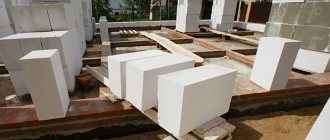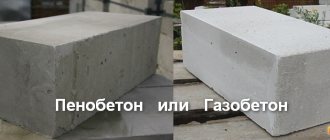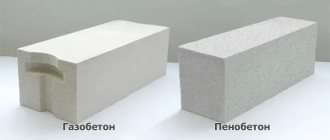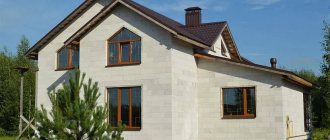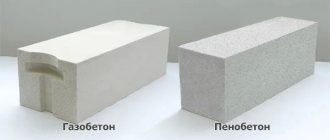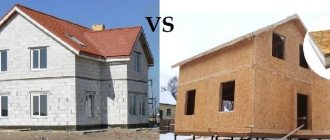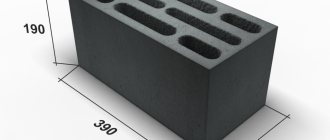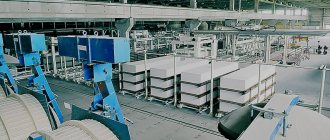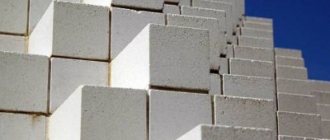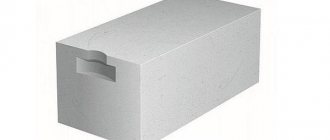For each specific task, you need your own brand of aerated concrete, which has an advantage in one or another parameter. In this article we will look at the brands, types, classes and main characteristics of gas blocks that will help you decide on your question. But first, let’s figure out what the brand means and draw up a table of brand correspondence to class and strength.
The grade of aerated concrete is a number that shows the density of the material. That is, the D300 brand means that the density of such aerated concrete is 300 kg/m3.
Note that this number is determined when the block is dry.
If aerated concrete is used for the construction of load-bearing walls , then autoclaved aerated concrete grade D400 is quite suitable for the construction of a one-story house. For a two-story building, it is better to use the D500. For taller buildings, aerated concrete grades D600 and higher are used. But we wrote this very conditionally, since by increasing the thickness of the blocks, the load-bearing capacity also increases.
For the construction of non-load-bearing external walls, brands D300, D400 are suitable. This option is often used in the construction of monolithic multi-storey buildings.
Brand of aerated concrete for partitions
Almost any brand is suitable
for interior partitions For partitions, sound insulation and the ability to fasten various hanging elements, such as shelves, cabinets, boilers, are important. In this regard, the D500/D600/D700 brands, with a thickness of 75 to 200 mm, are better suited. Brand, class, compressive strength
| Brand of aerated concrete | Compressive strength class | Average strength ( kg/cm²) |
| D300 (300 kg/m³) | B0.75 - B1 | 10 — 15 |
| D400 | B1.5 - B2.5 | 25 -32 |
| D500 | B1.5 - B3.5 | 25 — 46 |
| D600 | B2 - B4 | 30 — 55 |
| D700 | B2 - B5 | 30 — 65 |
| D800 | B3.5 - B7.5 | 46 — 98 |
| D900 | B3.5 - B10 | 46 — 13 |
| D1000 | B7.5 - B12.5 | 98 — 164 |
| D1100 | B10 - B15 | 131 — 196 |
| D1200 | B15 - B20 | 196 — 262 |
If we divide the brands of aerated concrete into types, they are divided into thermal insulation and structural . Thermal insulation grades have a density (up to 300 kg/m3), structural grades from 400 to 1200.
This division is explained simply: the higher the density of aerated concrete, the stronger it is, but at the same time it retains heat less well.
If you look at it in even more detail, it’s all about the air pores of aerated concrete, which affect the thermal, strength, sound insulation and other characteristics, but more on that later in the text.
It is very important to know that from different manufacturers of aerated concrete, with the same brand, the strength of the blocks can vary greatly.
After all, gas blocks are divided into autoclave and non-autoclave ; we have already described their differences in more detail in our article.
For now, we only note that autoclaved aerated concrete has much higher strength.
But if we compare the strength characteristics of gas blocks from well-known companies, such as Aeroc , StoneLight , UDK , then with the same brand their strength is approximately equal. These companies make a truly high-quality product using high-tech equipment.
Requirements for marking aerated concrete
Aerated concrete blocks are marked with indelible paint. All signs, information about the product and the manufacturer are applied in compliance with the requirements regarding resistance to moisture, precipitation and other external factors. All conditions must be met so that the consumer can clearly recognize the information he is interested in without resorting to additional means.
Mandatory information that is applied to products is:
- name of the manufacturing company;
- a trademark, if available, is not a mandatory requirement, but its registration is an additional advantage for the manufacturer;
- material class (compressive strength is taken into account);
- brand (frost resistance and average density are taken into account);
- Batch number;
- a mark that the product has passed technical control.
Special attention is paid to transport packaging. It must also be marked and contain the following information:
- name of the cargo recipient;
- name of destination;
- the name of the station where the cargo arrives, the number of places in the batch of products and its dimensions, the serial number of the place (if necessary).
The consumer can find out information about a building material using its brand.
The following types of aerated concrete exist:
- D600 – characterized by increased strength;
- D500 – used in the construction of monolithic structures;
- D400 - used to obtain high thermal insulation values;
- D350 - uncommon due to increased fragility.
Manufacturing companies produce different types of aerated concrete blocks, which differ in the following characteristics:
- overall dimensions of the product unit (thickness, height, block length);
- a connecting element (glue, mortar) that holds together the components of the product and is permitted by the current standard.
Due to the fact that each component of the product can vary, manufacturers produce ten different types of gas blocks. They are marked with numbers from I to X. The label must contain the following characteristics of aerated concrete:
- type of aerated block depending on its size;
- concrete compression class;
- brand depending on the average density of the material;
- brand depending on frost resistance.
The bar code is considered an important element of labeling. A manufacturer who decides to apply a barcode to labels and packaging receives a number of benefits. Barcoding allows you to:
- simplify accounting of product movements;
- speed up inventory;
- place goods for sale in construction hypermarkets and large retail chains.
In the process of marking aerated concrete blocks, a manufacturing enterprise can register a bar code to be applied to a single product, transport packaging container and group packaging for a batch of products.
It is advisable to place barcodes on several sides of the package. The size of the codes must be sufficient to read, the graphic image must be clear, otherwise reading may be difficult.
Since current legislation does not provide for mandatory certification of aerated concrete, manufacturers and suppliers can additionally issue the following documentation:
- Voluntary certificate of conformity - this document will help highlight the exceptional properties of the material. To obtain it, you must follow GOST. If the product does not meet all the characteristics or has its own characteristics, it is necessary to develop your own technical specifications. The certificate is often included in the mandatory package of tender documents and also helps to strengthen consumer confidence.
- Fire certificate - confirms the material’s compliance with fire safety standards established in Federal Law of the Russian Federation No. 123.
- Expert opinion (EO) – confirms the safety of the product for consumer health and its compliance with approved sanitary and hygienic standards.
Influence of brand on the characteristics of aerated concrete
Thermal conductivity . The lower the thermal conductivity coefficient, the better the heat is retained. For aerated concrete brand D350 , the thermal conductivity coefficient is from 0.075 (W/m2), and for a block of brand D700 - 0.25 (W/m2).
Strength and density . Let us repeat that the higher the density of aerated concrete, the stronger and cooler the block. The density of aerated concrete can be from 200 to 1200 kg/m3, which corresponds to the brand.
Fire resistance . Aerated concrete of any brand is fire-resistant, that is, it does not support combustion and can withstand high temperatures.
Vapor permeability . This parameter shows the ability of the material to transmit water vapor at a difference in partial pressure.
How to choose gas silicate blocks and what are the properties of gas silicate
Gas silicate blocks are an artificial stone that is produced at very large enterprises. The production facilities are equipped with high-tech equipment, without which it is impossible to produce the product. The quality of each batch and compliance of the material with established requirements is checked by quality control specialists.
The composition of gas silicate includes:
- cellular silicate concrete;
- gasifier (aluminum powder);
- binder (finely ground silicate mixture of lime and silica);
The porous structure of aerated blocks is the result of a chemical reaction between lime and aluminum, which, when decomposed, form hydrogen. Gas silicate contains no cement, and this affects the following two factors.
- Firstly, the color - it's white.
- Secondly, on the hardening method. When producing gas silicate, natural hardening of blocks is unacceptable. It is performed in autoclave ovens at high pressure (8-13 atm) and a temperature of about +200C.
When choosing gas silicate, you should pay attention to the manufacturer. As a rule, a company with a good reputation offers a large selection of blocks of varying sizes and technical characteristics. A good manufacturer places very strict requirements on its products. For example, for some companies, the permissible deviations in dimensions are only 0.4-0.7 mm with a block length of 600 mm.
Specifications
When purchasing, you should pay attention not only to the manufacturer, but also to the following criteria:
- density;
- frost resistance;
- thermal conductivity;
- vapor permeability;
- compressive strength;
- drying shrinkage.
Currently, manufacturers produce silicate blocks with a density of D-300 kg/cub.m. and higher. The number indicates the dry density and is indicated on the label. It defines the purpose of the block. For example, the D-500 gas block optimally combines strength and thermal conductivity. This material is suitable for the construction of internal and external load-bearing walls. When choosing a building material, you can follow the following rules:
- the higher the density, the stronger the material;
- the lower the density, the higher the frost resistance;
- the lower the density, the lower the thermal conductivity.
The frost resistance of gas silicate blocks depends on the volume of air cells. As a rule, modern gas blocks can withstand up to thirty-five freeze-thaw cycles. But there are enterprises that have mastered the production of products that can withstand one hundred cycles. The number of cycles is indicated by the block density. D-500 can withstand 35 cycles without any apparent reason for failure.
Gas silicate has very high thermal conductivity. They depend on the block density.
- D-400 - 0.8-0.10;
- D-500, D-700 - 0.12-0.18;
- D-700 and higher - 0.18-0.20.
The vapor permeability of an aerated block is inversely proportional to its density. But even with the densest gas silicates it is very high, which means there is always fresh air in the house.
The choice of gas silicate block is influenced by such an indicator as compressive strength. Sometimes, due to their porous structure and low weight, gas silicates can cause mistrust among consumers. It may seem at first glance that the material does not have sufficient strength.
However, it is not. The strength characteristics of an autoclaved gas block are quite high. An aerated block with a D-400 rating is quite enough to build a three-story house. And from D-300 you can build a two-story house with light ceilings. When choosing blocks, find the letter B in the markings and pay attention to the number that stands next to it. For example, B2.0 will mean that the block can withstand 20 kg per 1 cm2.
Important! The load-bearing capacity of aerated concrete strongly depends on characteristics such as thickness, height and nature of the load.
Drying shrinkage is the process of natural deformation of a material. Most of all, it is characteristic of blocks in which cement is used as the only binder. Autoclaved aerated blocks are much more resistant to drying out. The reason is tobermorite compounds penetrating into the structure of the block during autoclave processing. They increase resistance to deformation by twenty-five percent. To minimize shrinkage, choose D-700 and higher for load-bearing walls.
Almost all of the listed characteristics are indicated in the block labeling. The markings also indicate the dimensions.
Appearance
The shape of block gas silicate is a regular parallelepiped. The length of the block should not exceed 625mm, width - 500mm, thickness - 500mm. Deviations in dimensions are permissible, but they must comply with the following parameters:
- Block gas silicate for dry masonry or with glue - thickness, length, height no more than 1.5 mm.
- Block gas silicate for adhesive masonry - thickness, length, height no more than 2.0 mm.
- Block gas silicate for masonry on mortar - no more than 3.0 mm.
The surface of the block can be smooth or with locking elements (grooves). To build an energy-efficient house, it is better to choose blocks with grooves. They need to be glued. If you correctly spread the glue on the grooves and lay the tongue-and-groove blocks, then the vertical through seams will be eliminated almost completely. This means that heat loss will be minimal.
How does the brand of aerated concrete differ from the class?
The grade is called the average compressive strength, that is, in one batch of aerated blocks there may be blocks whose strength differs from each other by 10-20 percent. But on average for all blocks, the brand will be indicated on the packaging.
The class of aerated concrete shows the guaranteed strength of the blocks, which cannot be lower.
In other words, the brand is the average value of strength, and the class is the guaranteed value. For serious calculations, it is the strength class, not the brand, that is used.
What is needed to complete the procedure
To obtain voluntary certificates, electronic certificates, barcoding and labeling of aerated concrete, you must submit an application to the certification center. After this, the applicant provides:
- registration documentation of the enterprise, details for drawing up an agreement;
- description of the product with test samples;
- GOST or TU, on the basis of which the material is manufactured;
- supply agreement with accompanying documentation – for importers;
- additional information upon request of the expert.
Dependence of sound insulation on the brand of aerated concrete
Sound insulation (noise absorption), this parameter is measured in decibels (dB), and shows what level of noise does not pass through the wall.
The thicker the wall, the better the level of sound insulation. The brand of aerated concrete directly affects sound absorption, and the higher the density, the less noise. Sound absorption table of aerated concrete
| Noise insulation index (dB) for different thickness of aerated concrete (mm) | |||||
| Brand of aerated concrete | 100 | 150 | 200 | 250 | 300 |
| D300 | 29 | 35 | 40 | 43 | 46 |
| D400 | 31 | 41 | 43 | 47 | 50 |
| D500 | 34 | 42 | 46 | 50 | 53 |
| D600 | 36 | 44 | 47 | 52 | 55 |
In other words, if a wall made of aerated concrete has a sound absorption of 40 dB, then quieter sounds will not pass through it, and if the sound from the street is 50 dB, then only 10 dB of them will pass through.
Stages of registration
The procedure is carried out in stages:
- The application is submitted in the prescribed form.
- The applicant prepares the required documentation and, if necessary, develops technical specifications.
- Products undergo evaluation activities, the results of which are recorded in the protocol. Labels and packaging of building materials are marked.
- The applicant receives ready-made permits and evidentiary materials.
If you have any questions, contact the portal experts for a free consultation.
